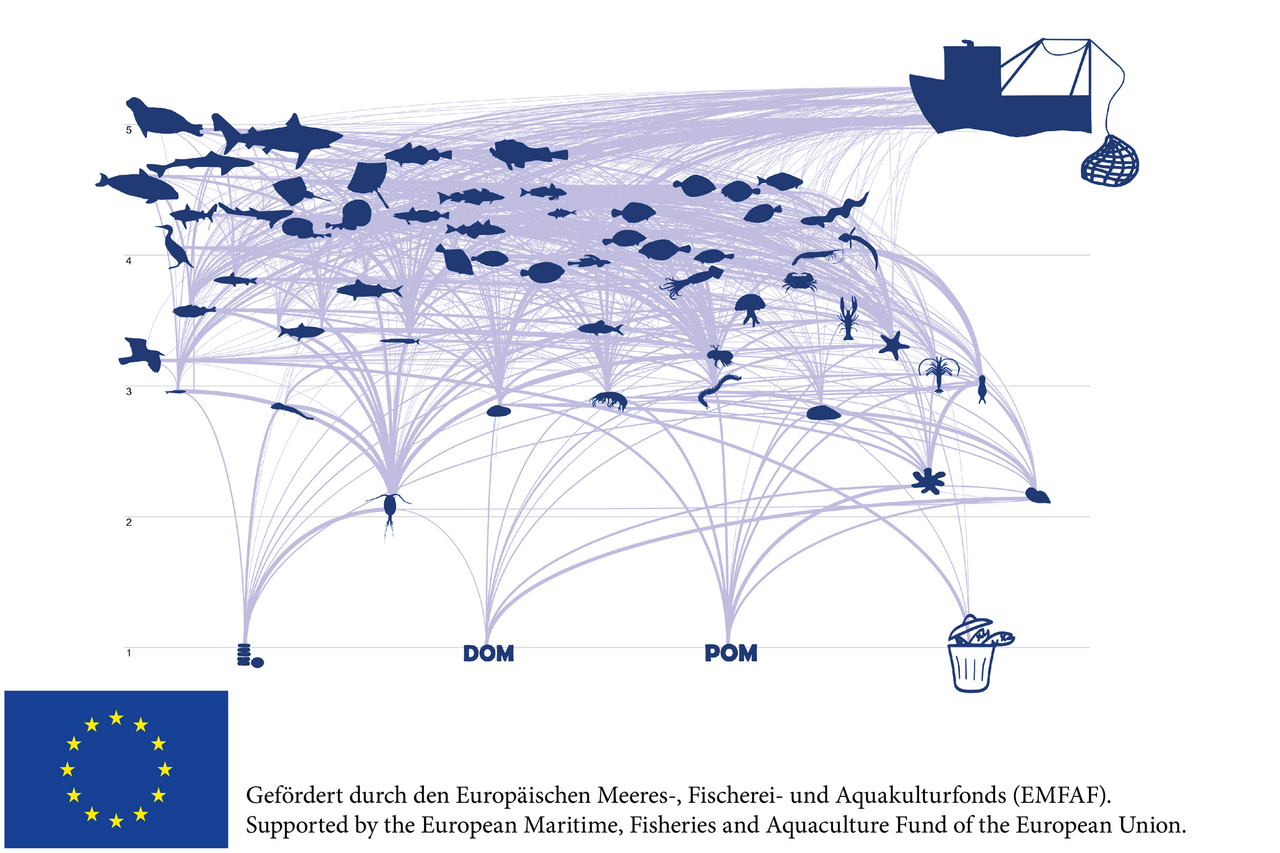Project
Enhancement of multi-species assessment models

This research activity will enhance multi-species models (improved diet selection models and recruitment models) to enable best possible projections of stock developments. This will contribute to a sustainable harvest of fish stocks inside an ecosystem approach. Not only fisheries influence fish stocks but also predation and environmental factors.
Background and Objective
The ecosystem approach to fisheries management plays an increasingly important role in the EU Common Fisheries Policy (CFP). In contrast to traditional fisheries management, not only the influence of management decisions on target species has to be evaluated but the impact on the ecosystem as a whole. Among other things, this requires the utilisation of multi-species models capable of quantifying the interactions between fish stocks (e.g. predator-prey relationships). In addition, new management concepts have to be developed that can tackle the new challenges of an ecosystem approach. This research activity will enhance multi-species models (improved diet selection models and recruitment models) to enable best possible projections. This will contribute to a sustainable harvest of fish stocks inside an ecosystem approach. The models will be updated every year with recent data. Model results (i.e. estimates of current predation mortalities) will be made available to ICES working groups to improve the assessment of commercially important fish stocks.
Target Group
Science, ICES advice
Approach
Stomach data are used as basis for analyses on the diet selection of predators and to parameterise multi-species models. Complex feeding interactions can be qunatified with these models and management strategies can be evaluated in a multi-species context.
Our Research Questions
- How important is natural mortality compared to fishing mortality?
- How variable is predation mortality over time and how does fishing influence marine food webs?
- Is the current single-species managment really useful?
- How could multi-species management plans look like?
Preliminary Results
- Data provision and participation in ICES working groups
- Various publications
Links and Downloads
Thünen-Contact

Involved Thünen-Partners
Involved external Thünen-Partners
- Internationaler Rat für Meeresforschung (ICES)
(Kopenhagen, Dänemark) -
Universität Hamburg
(Hamburg, Deutschland) - Danish Technical University (DTU)
(Kopenhagen, Hirtshals, Charlottenlund, Dänemark)
Funding Body
-
European Union (EU)
(international, öffentlich) -
EU - European Maritime and Fisheries Fund (EMFF)
(international, öffentlich)
Duration
1.2008 - 12.2027
More Information
Project status:
ongoing
Publications
- 0
Lauerburg RAM, Temming A, Pinnegar JK, Kotterba P, Sell AF, Kempf A, Floeter J (2018) Forage fish control population dynamics of North Sea whiting Merlangius merlangus. Mar Ecol Progr Ser 594:213-230, DOI:10.3354/meps12533
- 1
Ulrich C, Vermard Y, Dolder PJ, Brunel T, Jardim E, Holmes SJ, Kempf A, Mortensen LO, Poos JJ, Rindorf A (2017) Achieving maximum sustainable yield in mixed fisheries: a management approach for the North Sea demersal fisheries. ICES J Mar Sci 74(2):566-575, DOI:10.1093/icesjms/fsw126
- 2
Tam JC, Link JS, Large SL, Bogstad B, Bundy A, Cook AM, Dingsoer GE, Dolgov AV, Howell D, Kempf A, Pinnegar JK, Rindorf A, Schückel S, Sell AF, Smith BE (2016) A trans-Atlantic examination of haddock Melanogrammus aeglefinus food habits. J Fish Biol 88(6):2203-2218, DOI:10.1111/jfb.12983
- 3
Stäbler M, Kempf A, Mackinson S, Poos JJ, Garcia C, Temming A (2016) Combining efforts to make maximum sustainable yields and good environmental status match in a food-web model of the southern North Sea. Ecol Model 331:17-30, DOI:10.1016/j.ecolmodel.2016.01.020
- 4
Cormon X, Kempf A, Vermard Y, Vinther M, Marchal P (2016) Emergence of a new predator in the North Sea: evaluation of potential trophic impacts focused on hake, saithe, and Norway pout. ICES J Mar Sci 73(5):1370-1381, DOI:10.1093/icesjms/fsw050
- 5
Cormon X, Ernande B, Kempf A, Vermard Y, Marchal P (2016) North Sea saithe Pollachius virens growth in relation to food availability, density dependence and temporature. Mar Ecol Progr Ser 542:141-151, DOI:10.3354/meps11559
- 6
Kempf A, Stelzenmüller V, Akimova A, Floeter J (2013) Spatial assessment of predator–prey relationships in the North Sea: the influence of abiotic habitat properties on the spatial overlap between 0-group cod and grey gurnard. Fisheries Oceanogr 22(3):174-192, DOI:10.1111/fog.12013
- 7
Kempf A, Dingsoer GE, Huse G, Vinther M, Floeter J, Temming A (2010) The importance of predator-prey overlap: predicting North Sea cod recovery with a multispecies assessment model. ICES J Mar Sci 67(9):1989-1997
- 8
Kempf A, Floeter J, Temming A (2009) Recruitment of North Sea cod (Gadus morhua) and Norway pout (Trisopterus esmarkii) between 1992 and 2006: the interplay between climate influence and predation. Can J Fish Aquat Sci 66(6):633-648, DOI:10.1139/F09-022
- 9
Kempf A, Floeter J, Temming A (2008) Predator-prey overlap induced Holling type III functional response in the North Sea fish assemblage. Mar Ecol Progr Ser 367:295-308, DOI:10.3354/meps07555

![[Translate to English:] [Translate to English:]](/media/_processed_/7/1/csm_IMG_7977_large_1defaf5de1.jpg)

![[Translate to English:] Logo des Bundesministerium für Ernährung und Landwirtschaft](/media/allgemein/logos/BMEL_Logo.svg)